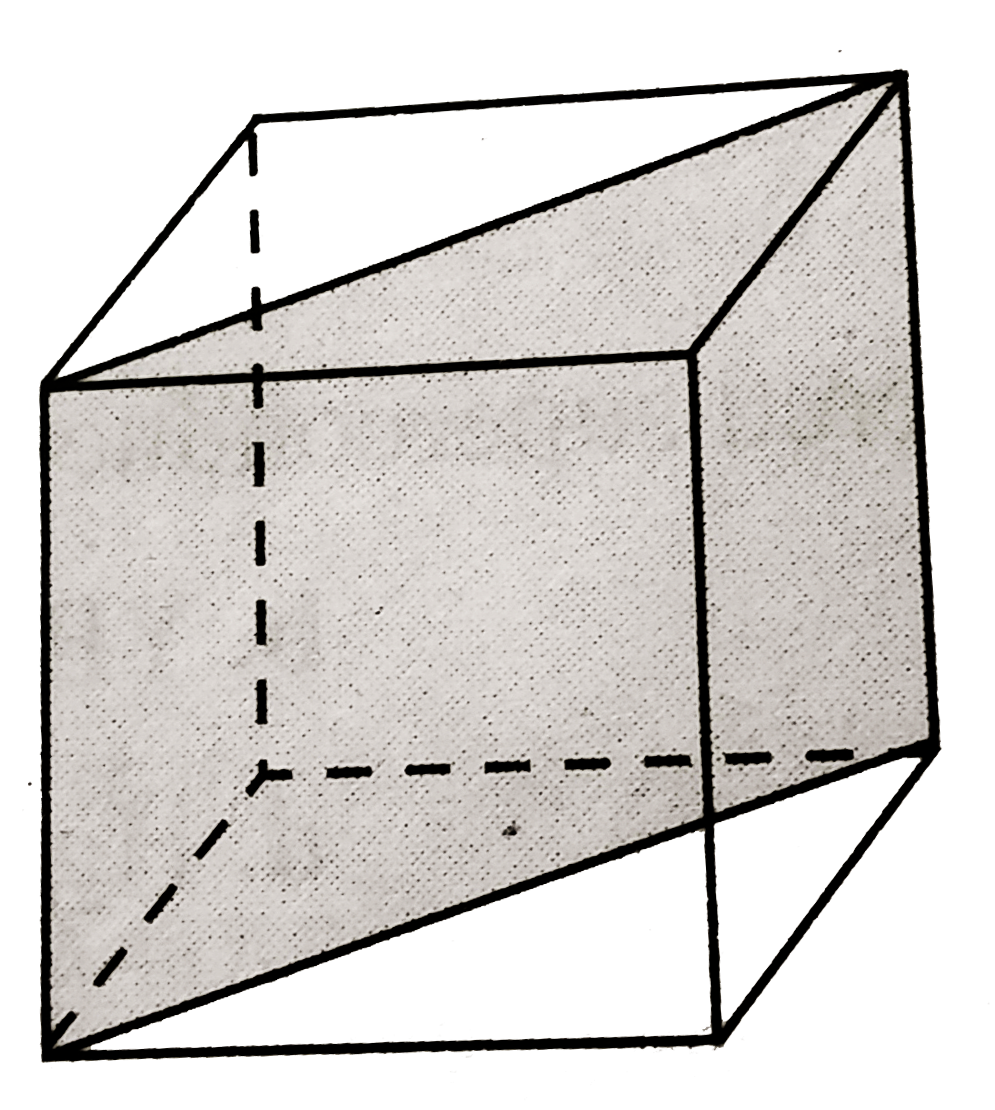Select the corrent statement (s)
(a) The C.N. of cation occupying a tetrahedral hole is 4
(b) The C.N. of cation occupying an octabedral hole is 6
(c ) In schottky defects, density of the lattice decreases
I, II
II, III
I, II, III
I, III
The correct Answer is:C
To solve the question, we need to analyze each statement regarding the coordination number of cations in tetrahedral and octahedral holes, as well as the effect of Schottky defects on the density of the lattice.
1. Understanding Coordination Number:
- The coordination number (C.N.) is defined as the number of nearest neighboring atoms or ions surrounding a central atom or ion in a crystal lattice.
2. Analyzing Statement (a):
- Statement (a): "The C.N. of cation occupying a tetrahedral hole is 4."
- In a tetrahedral void, there are four atoms surrounding the void: three at the base and one at the apex. Therefore, the cation in a tetrahedral hole is in contact with four neighboring atoms.
- Conclusion: This statement is true.
3. Analyzing Statement (b):
- Statement (b): "The C.N. of cation occupying an octahedral hole is 6."
- In an octahedral void, there are six atoms surrounding the void: three on the bottom and three on the top. Thus, the cation in an octahedral hole is in contact with six neighboring atoms.
- Conclusion: This statement is true.
4. Analyzing Statement (c):
- Statement (c): "In Schottky defects, density of the lattice decreases."
- A Schottky defect occurs when equal numbers of cations and anions are missing from the crystal lattice. This results in a decrease in the total number of ions present in the lattice, which in turn leads to a decrease in the density of the lattice.
- Conclusion: This statement is true.
5. Final Conclusion:
- Since all three statements (a), (b), and (c) are true, the correct answer is that all statements are correct.
Final Answer:
All statements (a), (b), and (c) are correct.
---
- The coordination number (C.N.) is defined as the number of nearest neighboring atoms or ions surrounding a central atom or ion in a crystal lattice.
- Statement (a): "The C.N. of cation occupying a tetrahedral hole is 4."
- In a tetrahedral void, there are four atoms surrounding the void: three at the base and one at the apex. Therefore, the cation in a tetrahedral hole is in contact with four neighboring atoms.
- Conclusion: This statement is true.
- Statement (b): "The C.N. of cation occupying an octahedral hole is 6."
- In an octahedral void, there are six atoms surrounding the void: three on the bottom and three on the top. Thus, the cation in an octahedral hole is in contact with six neighboring atoms.
- Conclusion: This statement is true.
- Statement (c): "In Schottky defects, density of the lattice decreases."
- A Schottky defect occurs when equal numbers of cations and anions are missing from the crystal lattice. This results in a decrease in the total number of ions present in the lattice, which in turn leads to a decrease in the density of the lattice.
- Conclusion: This statement is true.
- Since all three statements (a), (b), and (c) are true, the correct answer is that all statements are correct.
All statements (a), (b), and (c) are correct.
Topper's Solved these Questions
- THE SOLID STATEBOOK - VMC MODULES ENGLISHCHAPTER - THE SOLID STATEEXERCISE - ENABLE
50 Videos
- THE SOLID STATEBOOK - VMC MODULES ENGLISHCHAPTER - THE SOLID STATEEXERCISE - EFFICIENT
50 Videos
- THE SOLID STATEBOOK - VMC MODULES ENGLISHCHAPTER - THE SOLID STATEEXERCISE - JEE Advance ( Archive )
27 Videos
- SURFACE CHEMISTRYBOOK - VMC MODULES ENGLISHCHAPTER - SURFACE CHEMISTRYEXERCISE - PRACTICE EXERCISE
9 Videos
- THEORY OF SOLUTIONSBOOK - VMC MODULES ENGLISHCHAPTER - THEORY OF SOLUTIONSEXERCISE - JEE Advanced (Archive)
31 Videos
Similar Questions
In a hypothetical solid C atoms form C C P lattice with A atoms occupying all the Tetrahedral Voids and B atoms occupying all the octahedral voids A and B atoms are of the appropriate size such that there is no distortions in the CCP lattice. Now if a plane is cut ( as shown ) then the section would like

View SolutionDefects which do not disturb the stoichiometry are called stochiometric defect. At the time of crystal formation an ion may not occupy its expected position leaving a void or hole at that site. As a metter of fact one positive and one negative ion are missing from their respective positions leaving behind a pair of holes. This vacancy is a Schottky defect. Due to this defect density decreases. Defect arises in which certain atoms or ions have migrated to interstitial position some distance removed from the holes which they vacated. In this case there is no change in the density of the crystal.
In the Schottky defect
View Solution
Knowledge Check
Assertion: In crystal lattice, the size of the tetrahedral hole is large than an octahedral hole.
Reason: The cations occupy more space than anions in crystal packing.AIf both assertion and reason are true and reason is the correct explanation of assertion.BIf both assertion and reason are true, but reason is not the correct explanation of assertion.CIf assertion is true, but reason is false.DIf both assertion and reason are false
Defects which do not disturb the stoichiometry are called stochiometric defect. At the time of crystal formation an ion may not occupy its expected position leaving a void or hole at that site. As a metter of fact one positive and one negative ion are missing from their respective positions leaving behind a pair of holes. This vacancy is a Schottky defect. Due to this defect density decreases. Defect arises in which certain atoms or ions have migrated to interstitial position some distance removed from the holes which they vacated. In this case there is no change in the density of the crystal.
Mark the false statement :
View SolutionDefects which do not disturb the stoichiometry are called stochiometric defect. At the time of crystal formation an ion may not occupy its expected position leaving a void or hole at that site. As a metter of fact one positive and one negative ion are missing from their respective positions leaving behind a pair of holes. This vacancy is a Schottky defect. Due to this defect density decreases. Defect arises in which certain atoms or ions have migrated to interstitial position some distance removed from the holes which they vacated. In this case there is no change in the density of the crystal.
Frenkel defect is generally observed in
View SolutionIn a hypothetical solid, C atoms are found to form cubical close-packed lattice. A atoms occupy all tetrahedral voids and B atoms occupy all octahedrals voids.

A and B atoms are of appropriate size, so that there is no distortion in the p lattice of C atoms. Now if a plane as shown in the following figure is cut, then the cross section of this plane will look like
View SolutionIn a hypothetical solid, C atoms are found to form cubical close-packed lattice. A atoms occupy all tetrahedral voids and B atoms occupy all octahedrals voids.

A and B atoms are of appropriate size, so that there is no distortion in the p lattice of C atoms. Now if a plane as shown in the following figure is cut, then the cross section of this plane will look like
View SolutionIn a crystalline solid, having formula AB2O4 oxide ions are arranged in cubic close packed lattice while cations A are present in tetrahedral voids and cations B are present in octahedral voids.
(a) What percentage of the tetrahedral voids is occupied by A?
(b) What percentage of the octahedral voids is occupied by B ?
View SolutionIn a crystalline solid, having formula AB2O4 oxide ions are arranged in cubic close packed lattice while cations A are present in tetrahedral voids and cations B are present in octahedral voids.
(a) What percentage of the tetrahedral voids is occupied by A?
(b) What percentage of the octahedral voids is occupied by B ?
View SolutionDefects which do not disturb the stoichiometry are called stochiometric defect. At the time of crystal formation an ion may not occupy its expected position leaving a void or hole at that site. As a metter of fact one positive and one negative ion are missing from their respective positions leaving behind a pair of holes. This vacancy is a Schottky defect. Due to this defect density decreases. Defect arises in which certain atoms or ions have migrated to interstitial position some distance removed from the holes which they vacated. In this case there is no change in the density of the crystal.
In stoichiometric defects, the ratio of positive and negative ions as indicated by chemical formula of the compound
View Solution
